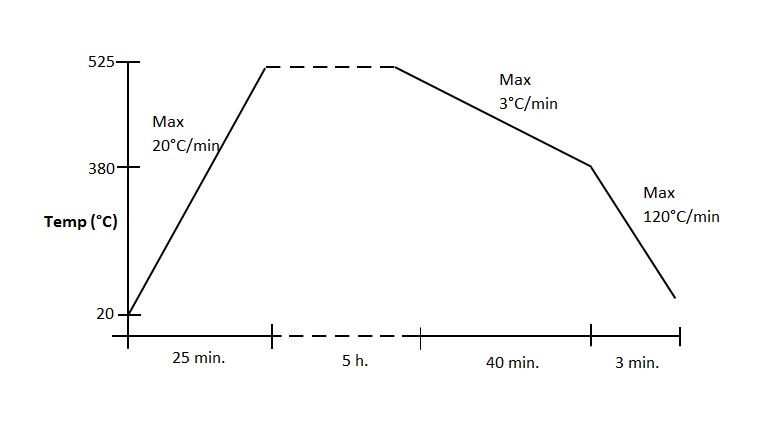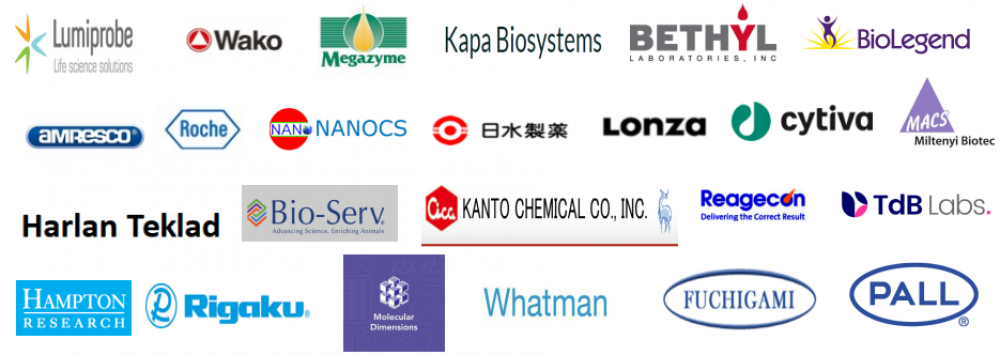Megazyme膳食纤维总量检测试剂盒
上海金畔生物科技有限公司
品牌:Megazyme
英文名:Total Dietary Fibre Assay Kit
货号:K-TDFR-200A
规格:200 assays per kit
分析物意义:小肠不能消化的碳水化合物
Megazyme检测试剂盒优点:试剂稳定。成本低。AOAC方法985.29和991.43;AACC方法32-07和32-21
The Total Dietary Fiber test kit is suitable is suitable for the measurement and analysis of Total Dietary Fiber.
For the determination of Total Dietary Fiber in cereal products,
foodstuffs, feeds and other materials
Principle:
(α-amylase + amyloglucosidase)
(1) Starch + H2O → D-glucose
(protease)
(2) Protein + H2O → peptides
(3) Dietary fiber determined gravimetrically following alcohol
precipitation
(4) Ash and residual protein determined on DF residues
and subtracted
Kit size: 100 / 200 assays
Method: Hydrolysis / removal of non-dietary
fibre components
Total assay time: ~ 100 min
Detection limit: 0.5-100% of sample weight
Application examples:
Food ingredients, food products and other materials
Method recognition:
AOAC (Methods 985.29, 991.42, 991.43 and 993.19), AACC
(Methods 32-05.01, 32-06.01, 32-07.01 and 32-21.01) and
CODEX (Type I Method)
Total Dietary Fiber Assay Kit, for the measurement and analysis of total, soluble and insoluble dietary fiber according to AOAC and AACC approved methods. See General Referee Reports: Journal of AOAC INTERNATIONAL, Vol. 81, No. 1, 1998.
Fiber is a mixture of complex organic substances, including hydrophilic compounds, such as soluble and insoluble polysaccharides and non-digestable oligosaccharides, as well as a range of non-swellable, more or less hydrophobic, compounds such as cutins, suberins and lignins. The procedures for the determination and analysis of total dietary fiber as outlined in our booklet are based on the methods of Lee et al.1 and Prosky et al.2,3 (AOAC 991.43, AOAC 985.29, AACC 32-07.01 and AACC 32-05.01). However, the enzymes in the Megazyme Total Dietary Fiber Kit can also be used in other dietary fiber analytical methods such as AACC Method 32-21.01 and AACC Method 32-06.01.
1. Association of Official Analytical Chemists. (1985). Official Methods of Analysis, 14th ed., 1st suppl. Secs. 43, A14-43, A20, p.399.
2. Association of Official Analytical Chemists. (1986). Changes in methods. J. Assoc. Off. Anal. Chem., 69, 370.
3. Association of Official Analytical Chemists. (1987). Changes in methods. J. Assoc. Off. Anal. Chem., 70, 393.
Two separate methods are described in the associated data booklet:
METHOD 1:
DETERMINATION OF TOTAL, SOLUBLE AND INSOLUBLE DIETARY FIBER
Based on AOAC Method 991.43 “Total, Soluble, and Insoluble Dietary Fiber in Foods” (First Action 1991) and AACC Method 32-07.01 “Determination of Soluble, Insoluble, and Total Dietary Fiber in Foods and Food Products” (Final Approval 10-16-91).
METHOD 2:
DETERMINATION OF TOTAL DIETARY FIBER
Based on AACC method 32-05.01 and AOAC Method 985.29.
Advantages
- Very competitive price (cost per test)
- All reagents stable for > 2 years
- High purity / standardised enzymes employed
- Mega-Calc™ software tool is available from our website for hassle-free raw data processing
- Simple format
Q1. Should the pH of the sample be adjusted even for samples in acidic media?
The pH of the assay solution after the sample is added should be the same as that of the assay buffer that is supplied with the kit.
Low sample volumes (e.g. 0.1 mL) are not likely to affect the pH of the assay solution and therefore may not require pH adjustment.
Samples above 0.1 mL are more likely to affect the pH of the assay solution and therefore the pH of these samples should be adjusted as described in the data booklet, prior to addition to the assay.
Q2. What is the stability of enzymes for Total Dietary Fibre method?
The enzymes are very stable. In fact on storage at room temperature for 10 months, the decrease in activity of thermostable alpha-amylase and amyloglucosidase is less than 10% and the decrease in activity in protease is about 40%. When stored at 4˚C, the enzymes are stable for about 5 years, and at -20˚C they are stable for more than 10 years.
Q3. I was wondering if Megazyme has a kit to determine insoluble and soluble dietary fibre in barley?
Our kit is applicable to the measurement of Soluble, Insoluble and Total Dietary Fibre as per the AOAC/AACC methods. The main value of our kit is that the Amyloglucosidase is free of Cellulase, i.e. the Beta-Glucan will not be degraded and underestimated.
Q4. Are the lower temperatures of 90˚C to 95˚C adequate for the hydrolysis if we extend the incubation time?
The main reason for the stated 100˚C is to ensure that the starch is gelatinised and hydrolysed by alpha-amylase. We are sure that a temperature of 95˚C should be fine.
Q5. Is it necessary to do simultaneously nitrogen and ash analysis or can the test be applied to samples already analysed for these two characters?
It is necessary to measure the nitrogen in the residue. Most protein is removed by protease action. We think it best to follow the AOAC method as closely as possible.
Q6. There is an issue with the performance of the kit; the results are not as expected.
If you suspect that the Megazyme test kit is not performing as expected such that expected results are not obtained please do the following:
- Ensure that you have tested the standard sample that is supplied with the Megazyme test kit.
- Send the results of the kit standard, blank samples and the results obtained for your sample, in the relevant MegaCalc spreadsheet (if available) to Megazyme (cs@megazyme.com). Where available the relevant MegaCalc spreadsheet can be downloaded from where the product appears on the Megazyme website.
- State the kit lot number being used (this is found on the outside of the kit box).
- State which assay format was used (refer to the relevant page in the kit booklet if necessary).
- State exact details of any modifications to the standard procedure that is provided by Megazyme.
- State the sample type and describe the sample preparation steps if applicable.
Q7. Is there a preferred rate of heating and cooling for the recommended crucible (Corning® No. 32940-50C or equivalent) to avoid breakages?
The crucible has the potential to break if heated or cooled too rapidly . The graph below shows the manufacturer’s recommended heating and cooling profile for safe use with the crucible.
Q8. How should I prepare the required 78% ethanol solution?
A volume reduction occurs on mixing water with 95% ethanol (or IMS). 1 L of 78% ethanol is prepared by adding 821 mL 95% ethanol (or IMS) to 207 mL H2O.
If using a 1 L volumetric flask, this is best accomplished by placing 821 mL 95% ethanol (or IMS) into the volumetric flask. Dilute to volume with deionised water. Mix well. Check the level and if necessary add more deionised water to bring it back up to the 1 L mark.
百度云网盘下载:http://pan.baidu.com/s/1bpjvDwF
-
应用范围:
-
件
Megazyme产品所有分类:
生物及食品酶法试剂盒(Assay Kits)
膳食纤维/淀粉(Dietary Fiber/Starch) 单/双糖(Mono/Disaccharides) 多糖(Polysaccharides) 醇类(Alcohols) 有机酸(Organic Acids) 亚硫酸盐/氮(Sulfite/Nitrogen) 活性酶(Enzyme Activity) 试剂混合物(Reagent Mixtures) 其它(Other)
酶(Enzymes)
活性酶(Carbohydrate Active enZYmes )
淀粉酶(Amylases )
阿拉伯树胶酸(Arabinanases)
阿拉伯呋喃(Arabinofuranosidases)
纤维二糖水解(Cellobiohydrolases)
纤维素酶(Cellulases)
酯酶(Esterases)
果糖酶&果糖苷酶(Fructanases & Fructosidases)
岩藻糖苷酶(Fucosidases)
半乳聚糖酶(Galactanases)
半乳糖苷酶(Galactosidases)
葡聚糖酶(Glucanases)
葡萄糖苷酶(Glucosidases)
葡糖醛酸糖苷(Glucuronidases)
已糖胺酶类(Hexosaminidiases)
裂解酶(Lyases)
甘露聚糖酶(Mannanases)
甘露糖苷酶(Mannosidases)
支链淀粉酶(Pullulanases)
唾液酸酶(Sialidases)
木聚糖酶(Xylanases)
糖苷酶(Xylosidases)
木葡聚糖酶(Xyloglucanases)
多聚半乳糖醛酸(内切)酶(Polygalacturonases)
其它酶(Other Activities)
分析酶(Analytical Enzymes)
脱氢酶(Dehydrogenases)
异构酶(Isomerases)
激酶(Kinases)
磷酸酶(Phosphatases)
蛋白酶(Proteases)
其他活性酶(Other Activities)
糖类活性酶(Glycobiology Enzymes)
酶底物( Chromogenic Substra
